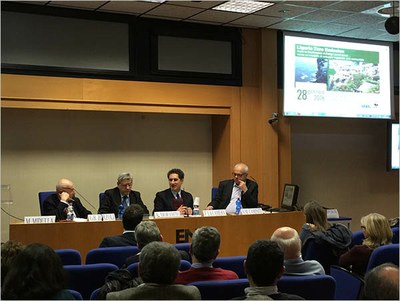Environment: ENEA-WWF, a green development model for Regions
18/2/2016
A sustainable development model replicable across other regions and the Country: it’s the objective of the study conducted by ENEA for the WWF Italia, evaluating innovative eco-friendly solutions based on renewables, energy efficiency and new technologies for energy storage and transport that could bring about over 4500 new jobs.
 Proposing a sustainable model of development replicable across other regions and the Country: it’s the objective of the study on the Liguria region conducted by ENEA for the WWF Italia, evaluating innovative eco-friendly solutions based on renewables, energy efficiency and new technologies for energy storage and transport that could create over 4500 new jobs.
Proposing a sustainable model of development replicable across other regions and the Country: it’s the objective of the study on the Liguria region conducted by ENEA for the WWF Italia, evaluating innovative eco-friendly solutions based on renewables, energy efficiency and new technologies for energy storage and transport that could create over 4500 new jobs.
In the next few years in Liguria, in terms of direct employment, over 4500 new jobs could stem from transitioning to a green and low carbon economy, requiring annual investments of about 391 million euro, as it emerges from the study presented in Rome today, called “Liguria, proposals for a zero emissions model of development”, that the WWF commissioned to ENEA. The ultimate goal is increasing the chances of a transition to a development model based on technologies and systems allowing to reduce greenhouse gas emissions and, consequently, the impact of climate change –as made clear by the recent Paris Agreement (COP21) and the European commitments- but also promoting energy efficiency, encouraging the development and innovation of the productive system and incentivizing employment, in line with the circular economy model.
According to the study, the whole range of proposals would enable the Liguria region to cut about 6 million tons of CO2 annually, halving per-capita emissions to about 3.6 tons of carbon dioxide equivalent (tCO2eq), compared to the current national average of about 7.1 tCO2eq.
“It’s not a regional energy plan, but an analysis of the options that can be developed and implemented over a few decades- says Roberto Morabito, Head of the ENEA Department for the sustainability of the productive and territorial systems- The objective is to identify a green and low carbon model of development replicable across other regions.”
“This study shows clearly and unmistakably – Donatella Bianchi, President of the WWF Italia said- as already today there are concrete and feasible solutions that would allow the Liguria region(and the whole country) to steer towards a low carbon economy, combat climate change and at the same time generate long-term and sustainable employment.
Fifteen out of over 30 technology options and their potential energy, environmental, economic and employment impacts were examined, arriving at a shortlist of interventions to be implemented in five strategical sectors: renewable electricity sources, thermal renewables, electrochemical storage in batteries, energy saving in the construction sector, sustainable transport system.
Some of the options appear promising (electric car) but not yet fully mature and their success will depend on international development trends and investments. Some are mature (photovoltaics) and their development is certain but still hindered by costs and limits of market organization. Others are ripe (energy upgrading of buildings) but hindered by organizational delays and access to adequate capital.
The study envisages the creation of about 2076 new jobs in the electric and thermal renewables sectors, 737 and 1339 respectively, a development requiring annual average investments of 166 million euro, of which 103 millions in electrical renewables and 63 millions in thermal renewables. In this way, 40% of the current regional demand for electric energy will be met by renewable energy sources, equivalent to about 2.5 terawatt hours (TWh= 1 billion kilowatt hours)
The energy upgrading of the building stock is another sector holding great potentials: an average annual investment of 209 million euro would bring about 2186 new jobs and the interventions performed on over 10thousand buildings would allow to cut energy consumption by 6o% compared to current levels, with an energy saving of 71thousand tons of oil equivalent - a 15% reduction of residential energy consumption- over a fifteen-year time span.
Overall, over a fifteen-year-span, the sectors of renewable energy sources and energy upgrading of buildings could bring about an average of 4262 new jobs for a total of 4500 with the addition of the electric storage sector.
Also the transport sector could provide a significant contribution that, although difficult to quantify in terms of new jobs, could deliver annual energy savings of about 310thousand tons of oil equivalent (toe) from the implementation of electric cars, electrification of wharfs, promotion of local public transport and use of railway transport to and from ports.
For more information please contact:
Natale Massimo Caminiti, Casaccia Research Center natale.caminiti@enea.it
The program of the event and the unabridged ENEA study (inclusive of the executive summary) can be found at: http://www.enea.it/it/comunicare-la-ricerca/events/wwf/liguriazeroemission
